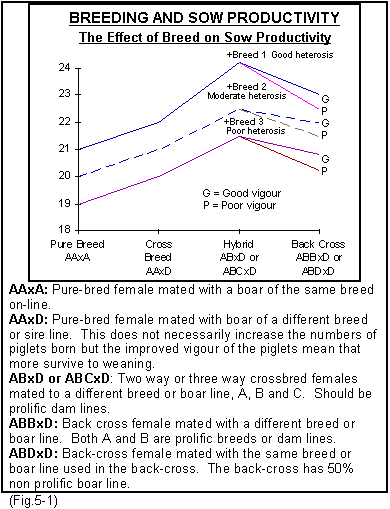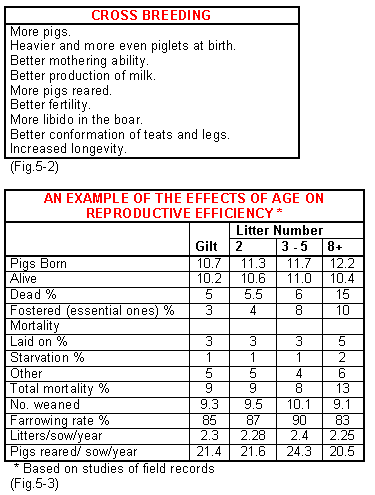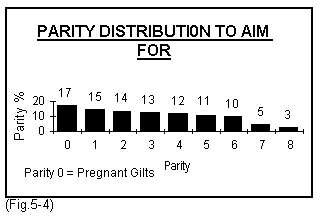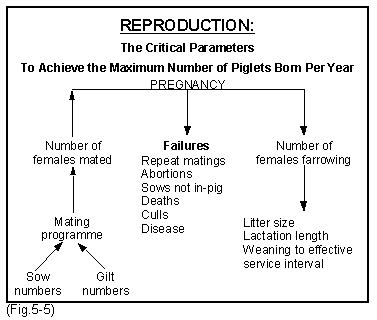



The breeding female
Problems associated with reproductive failure are often complex. In trying to resolve such problems it is essential to understand the important factors that maximise biological efficiency.
Key points to maximising reproductive performance
- Use the breed of female that is suitable for your system.
- Ensure that the breeding female exhibits good hybrid vigour.
- Monitor the age of the sow and her continuing performance.
- Collect the required records and use them to understand the problem.
- Ensure an even parity spread across the herd. Litters 3-5 are most productive.
- Use high levels of feed energy, protein and lysine in lactation and maximise feed intake.
- Provide an equitable environment with even temperatures. Cleanliness is essential.
- Compare the reproductive performance to the lactation length.
- Maintain good body condition throughout pregnancy.
- Have a sufficient number of boars available so that they need only be used once every 24 hours at most.
- Maintain sow health and immunity to disease.
- Assess the age of the gilt at first service, relative to life time performance in the herd.
- Assess the effectiveness of sow management from weaning to 21 days post-service.
- Make sure that the right type of stockperson is in charge of mating. The ability of the stockperson has a direct effect on reproductive performance
Most of the major breeding (seedstock) companies now develop lines rather than standard breeds. The lines are generally based on breeds but have been developed differently. Thus one line A may be based predominantly on the Large White breed but has been developed as a dam line by selecting for prolificacy (No. of piglets born alive per litter and No. of litters born per year) and mothering ability (No. of piglets weaned per sow per year). Line D may also be based on the Large White breed but has been developed as a sire line by selecting primarily for growth rate, feed conversion efficiency and lean meat. This sire line development is often done at the expense of prolificacy and so if you are a commercial producer you should never select female back-crosses sired by such boars for breeding.
Efficient reproduction starts with females of high genetic potential for prolificacy and this includes good hybrid vigour (heterosis). The hybrid female is the progeny of the male of one breed or dam line (A), crossed with the female of another breed or dam line (B) to produce the commercial F1 gilt (AB). This animal is usually highly prolific in terms of pigs produced per sow per year. Some breeding companies cross the F1 with a third breed or dam line (C) to produce their commercial hybrid or three way cross. Such pigs are designated by a variety of numbers and names and Fig.5-1, illustrates the differences that may occur between (ABxC) crosses depending on the level of hybrid vigour. Pure breeding produces the worst scenario, hence the reason why, at a commercial level no farmers should use pure bred females and boars of the same breed. In the past it has been common practice, commercially, to breed back from the F1 by using a boar of the same breed to produce a further breeding female that is 3/4 pure breed (A),1/4 alternate breed (B). However, there is invariably loss of hybrid vigour and even in farms that are efficient, performance is usually less efficient than the F1.

Fig.5-2 lists the essential features of different breeding combinations and it is important when selecting the source of your gilts to remember that there can be a considerable difference in the prolificacy of the dam lines and in the expression of hybrid vigour between one breeding company and another.

The age of the sow also plays an important part in reproductive efficiency. In Fig.5-3 you will see that the best reproductive performance is in litters 3, 4 and 5. Although by litter 8 the total number of pigs born may be greater there is often wide variation in the size of individual pigs at birth, an increasing number being too small or runts. There is also an increase in the numbers of stillborn with a reduction in live births. Furthermore, with age sows tend to be more clumsy and lazy, with higher levels of pigs laid on and an increased mortality, often 3% or more above those of the efficient parities. Sows in litters 3 to 5 should rear at least 24 pigs per annum but by the 8th litter and above this often drops below 21. Levels of reproductive efficiency should also be compared to those being achieved by the incoming gilts. Culling decisions should be made in light of the performance of your first litter gilts, the maintenance of the mating programme and the availability of older sows as foster mothers.
The parity distribution in the herd necessary to maximise production is shown in Fig.5-4.

Sow management from the day of weaning to 21 days post-service influences reproductive efficiency. If you have a problem, this is the first area that should be assessed.
Consider the overall plan in Fig.5-5 which defines the critical parameters necessary to maximise reproductive efficiency.

The maintenance of gilt and sow numbers is the first critical factor. There must always be sufficient females available to maintain a mating programme.
A shortfall in numbers available is the most common failure on most pig farms.
From point of mating to point of farrowing there can be a variety of pregnancy failures which are dealt with later in this chapter. For every 100 sows served in a given period of time less than 100 will farrow. This in percentage terms is described as the farrowing rate. Failures of animals to farrow are associated with repeat matings, abortions, sows not in-pig, deaths, culls and/or disease.
Farrowing Rate =
Nos. of sows farrowed x 100
Nos. of sows served
How to approach a problem on the farm
Of all the problems on the pig farm, understanding and resolving a reproductive problem can be the most challenging. However, if a logical approach is taken, the causes of the reproductive failures can usually be worked out and corrective actions taken. The approach outlined in Fig.5-6 relates the performance of the herd to accepted levels of efficiency, this then defines the area of failure and finally the problem is identified. Further investigations are then necessary to understand what has precipitated the problem and these are carried out by examining the management procedures, records and performing appropriate pathological tests. An important objective here is to determine if the problem is of infectious or non infectious origin or a combination of both. The end results are either farrowing rate loss, a reduced litter size, anoestrus or any combination.








